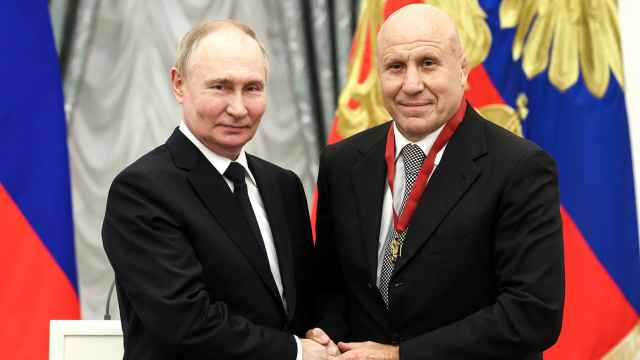As the possibility of free market competition in liquefied natural gas sales looms, Gazprom is preparing to do battle with potential domestic and international rivals.
The gas giant plans to take as much as 15 percent of the world LNG market, up from its 5 percent share today, Gazprom chief Alexei Miller said at annual shareholder meeting held at company's headquarters on Friday.
Europe's own gas production is decreasing, while many LNG producers prefer to supply premium markets in the Asia-Pacific region. As a consequence, Europe's share in world LNG imports decreased from 28 percent in 2009 to 21 percent in 2012, Miller said.
This resulted in some European countries having to pay higher gas bills.
"In Spring, the United Kingdom suffered from that and saw gas prices increase to up to two times what Gazprom offers for export," Miller said.
He also said Gazprom, which satisfies two thirds of Europe's gas needs, could make up for the difference using LNG.
During the first half of 2013, the monopoly's gas exports to Europe grew by 10 percent. More than 160 billion cubic meters of gas is planned to be supplied to Europe this year.
But despite rising sales volumes, the company expects its profit to fall by up to 10 percent this year due to rising taxes, lower growth in domestic gas prices and rebates to cash-strapped European clients, Reuters reported
While the role of pipeline gas for Europe has increased, it also means that Gazprom now has more opportunities on the LNG market, Miller said.
Liquefied natural gas has the advantage over pipelines that it can be shipped directly, without having to transit other countries, he added.
Like many other producers, Gazprom is considering the Asia-Pacific region as one of the main markets for its liquid gas exports.
"Estimates are that the Asia-Pacific region is to see the most demand for energy resources and it is here that we plan to expand our export operations, mainly by increasing our own production of LNG," Miller said.
Gazprom's Sakhalin-2 project on the country's eastern shore produced more than 10 million tons of LNG last year.
Last year, the company also made a decision to build an LNG plant near Vladivostok, with its first line scheduled to start operation in 2018. The facility will be capable of producing 10 million tons of LNG annually with an option to increase production to 15 million tons.
"This is a clear strategy by the company to diversify its operations," said Alexander Pasechnik, the head of the analytical department of National Energy Security Fund. "Only a few years back, Gazprom was happy with its main business, traditional pipeline gas supply, and now it is eyeing other opportunities."
But it is very important not to fall behind other players, he added. "There are many of them who have been present on the market for a long time — Qatar and the United States, with their shale gas development program, for example," Pasechnik said.
There are also domestic producers that are ready to start nipping at Gazprom's heels.
Top government officials have long expressed the idea that LNG exports should be liberalized. President Vladimir Putin and Prime Minister Dmitry Medvedev officially gave their support for the measure.
The latest voice of support came from Energy Minister Alexander Novak at the St. Petersburg Economic Forum at the end of June, who said the ministry had initiated market liberalization.
During the last 10 years, the annual growth of LNG trading volumes was 7.6 percent on average while pipeline gas sales grew by only 2.6 percent, he told BizTass.
While the decision to liberalize the market has not yet been announced, domestic companies are already preparing to increase LNG production.
"The competition here is growing; there are other companies that also want to get their share of gas exports," said Konstantin Cherepanov, and analyst with UBS Russia.
Russian independent gas producer Novatek has recently signed an agreement with China National Petroleum Corporation, or CNPC, on a joint venture to develop Yamal LNG project with plans to supply at least 3 million tons of LNG from Russia.
Novatek and CNPC's Yamal LNG plant is slated to eventually churn out 16.5 million tons of LNG per year.
Rosneft also has plans to start exporting LNG and is considering building an LNG production facility in the Far East together with ExxonMobil.
Experts said the potential export markets of LNG from Russia included China, India, both South and North Korea and Japan, which are markets Gazprom is targeting.
"The world energy market is changing," Cherepanov said. "Gas is now a resource that can be bought and delivered to any place in the world and there is less dependence on pipelines. And consumers are beginning to have an alternative to the few suppliers there were before."
Contact the author at a.panin@imedia.ru
Related articles:
A Message from The Moscow Times:
Dear readers,
We are facing unprecedented challenges. Russia's Prosecutor General's Office has designated The Moscow Times as an "undesirable" organization, criminalizing our work and putting our staff at risk of prosecution. This follows our earlier unjust labeling as a "foreign agent."
These actions are direct attempts to silence independent journalism in Russia. The authorities claim our work "discredits the decisions of the Russian leadership." We see things differently: we strive to provide accurate, unbiased reporting on Russia.
We, the journalists of The Moscow Times, refuse to be silenced. But to continue our work, we need your help.
Your support, no matter how small, makes a world of difference. If you can, please support us monthly starting from just $2. It's quick to set up, and every contribution makes a significant impact.
By supporting The Moscow Times, you're defending open, independent journalism in the face of repression. Thank you for standing with us.
Remind me later.






